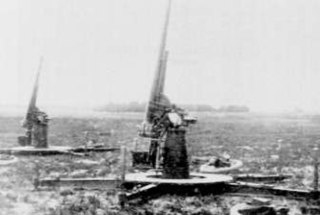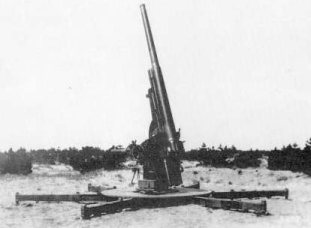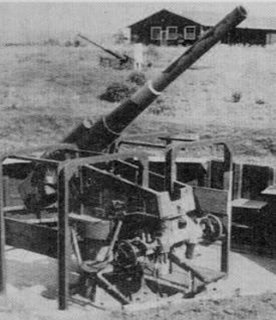 W
WArtillery in Japan was first used during the Sengoku period in the 16th century; and its use has continued to develop.
 W
WThe Japanese Coastal Defense Gun near Songsong on Rota in the Northern Marianas Islands, is a historic site that is listed on the U.S. National Register of Historic Places. The gun emplacement was built by the Japanese military in 1941. It was listed on the National Register in 1984.
 W
WThe Type 1 37 mm anti-tank gun was an anti-tank gun developed by the Imperial Japanese Army, and used in combat during World War II. The Type 1 number was designated for the year the gun was accepted, 2601 in the Japanese imperial year calendar, or 1941 in the Gregorian calendar.
 W
WThe Type 1 47 mm anti-tank gun was an anti-tank gun developed by the Imperial Japanese Army, and used in combat during World War II. The Type 1 number was designated for the year the gun was accepted, 2601 in the Japanese imperial year calendar, or 1941 in the Gregorian calendar.
 W
WThe Type 2 20 mm AA machine cannon was a Japanese-designed anti-aircraft gun, based on the German Flak 38. It entered service in 1942.
 W
WThe Type 3 12 cm AA gun was an anti-aircraft gun used in quantity by the Imperial Japanese Army during World War II.The Type 3 number was designated for the year the gun was accepted, 2603 in the Japanese imperial year calendar, or 1943 in the Gregorian calendar. It replaced the earlier Type 88 75 mm AA Gun in Japanese service.
 W
WThe Type 4 75 mm AA gun was an anti-aircraft gun developed by the Imperial Japanese Army. They started producing the gun in 1943. The Type 4 number was designated for the year the gun was accepted, 2604 in the Japanese imperial year calendar, or 1944 in the Gregorian calendar. Due to the lack of raw materials available and the great damage by air raids to its industrial infrastructure, only 70 units were made. These units were retained for defense of the Japanese home islands during World War II.
 W
WThe Type 5 15 cm AA gun was a large caliber anti-aircraft gun developed by the Imperial Japanese Army during the final days of World War II. The Type 5 number was designated for the year the gun was accepted, 2605 in the Japanese imperial year calendar, or 1945 in the Gregorian calendar. It was intended to replace the earlier Type 3 12 cm AA Gun as a defense against American air raids.
 W
WThe Type 11 75 mm anti-aircraft gun was an anti-aircraft gun used by the Imperial Japanese Army after World War I. The Type 11 designation was given to this gun as it was accepted in the 11th year of Emperor Taishō's reign (1922). It was the first anti-aircraft gun in Japanese service, but only a small number were produced, and it was superseded by the Type 14 10 cm gun and the Type 88 75 mm gun in active service before the start of World War II.
 W
WThe Type 14 10 cm AA gun was an anti-aircraft gun used by the Imperial Japanese Army after World War I. The Type 14 number was designated for the year the gun was accepted, the 14th year of Emperor Taishō's reign, 1929 in the Gregorian calendar. Only a small number were produced, and it was superseded by the Type 88 75 mm AA gun in production before the start of World War II.
 W
WThe Type 19 155 mm Wheeled Self-Propelled Howitzer is Japanese wheeled self-propelled gun. The vehicle is designed to replace Japan's inventory of FH70 Towed Howitzers.
 W
WThe Type 31 75 mm quick-firing gun was the main field gun deployed by the Imperial Japanese Army in the Russo-Japanese War of 1904–1905.
 W
WThe Type 60 81 mm self-propelled mortar was a Japan Ground Self-Defense Force (JGSDF) tracked armored mortar carrier that based on JGSDF Type 60 Armoured Personnel Carrier Type SU-II. The vehicle along with a parallel development of Type 60 107 mm self-propelled mortar. Its official abbreviation is 81MSP and also known as SV in the service. The vehicle had been phased out, with Type 60 107 mm self-propelled mortar since mid-to-late 1990s.
 W
WThe Type 60 107 mm self-propelled mortar was a Japan Ground Self-Defense Force (JGSDF) tracked armored mortar carrier that based on JGSDF Type 60 Armoured Personnel Carrier Type SU-II. The official abbreviation for the vehicle is 107MSP and also known as SX in JGSDF. The Type 60 has been replaced by newer Type 96 since mid-to-late 1990s.
 W
WThe Type 75 130 mm Multiple Rocket Launcher was developed to carry the 130 mm rocket system developed by the Aerospace Division of the Nissan Motor Company. It used the suspension, tracks and diesel engine of the Type 73 Armored Personnel Carrier. Komatsu was responsible for the chassis and IHI Aerospace, as Nissan's Aerospace Division has since been renamed, for the launcher and its rockets. 15 Type 75 wind measurement vehicles were built on the same chassis to provide weather information for the rockets.
 W
WThe Type 88 75 mm AA gun was an anti-aircraft gun used by the Imperial Japanese Army during the Second Sino-Japanese War and World War II. The Type 88 number was designated for the year the gun was accepted, 2588 in the Japanese imperial year calendar, or 1928 in the Gregorian calendar. It replaced the earlier Type 11 75 mm AA gun in front line combat service, and at the time was equal in performances to any of its contemporaries in western armies and was considered capable of handling any targets the Japanese army was likely to encounter on the Asian mainland. Although it was soon overtaken by improvements in aircraft technology and was largely obsolete by 1941, it continued to be used on many fronts until the end of the war.
 W
WThe Type 89 15 cm cannon was the main gun of the Imperial Japanese Army's heavy artillery units. The Type 89 designation was given to this gun as it was accepted in the year 2589 of the Japanese calendar (1929). It was widely used from the Manchurian Incident to the end of World War II, for example, Nomonhan, Bataan and Corregidor Island, Okinawa. The Type 89 15 cm gun was comparable to the U.S. M1918 155 mm GPF cannon, but the Type 89 had shorter range. The Type 89 was less efficient than similar heavy-caliber guns of other nations in World War II.
 W
WThe Type 96 120 mm self-propelled mortar is a tracked armored mortar carrier that was in Japan Ground Self-Defense Force (JGSDF) service since 1996. The official abbreviation for the vehicle is 120MSP and the common name is Jisou RT or Jisou 120 mota in JGSDF. It is nicknamed God Hammer.
 W
WThe Type 98 20 mm AA machine cannon was the most common light anti-aircraft gun of the Imperial Japanese Army. It entered service in 1938 and was used until the end of World War II. After World War II this gun was used by the Indonesian Army in the Indonesian National Revolution and North Vietnam in First Indochina War.
 W
WThe Type 99 88 mm AA gun was an anti-aircraft gun used by the Imperial Japanese Army during World War II. The Type 99's number was designated for the year the gun was accepted, 2599 in the Japanese imperial year calendar.